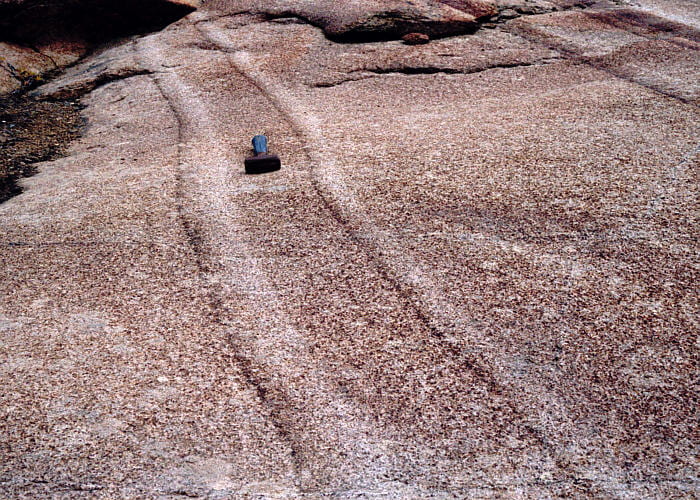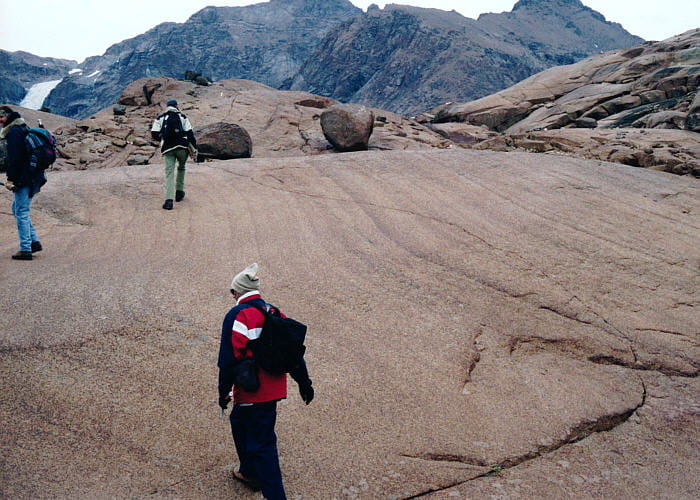The spectacular trough and ridge structures occur in the Layered Series UZa, and in some cases individual troughs extend up into UZb. They are most common in the Homestead area where all of the photos below were taken. The troughs are largely depositional features that were deposited at the same time as relatively featureless intervening ridges. The troughs do not have abundant scour and fill structures such as one finds in the cross bedded belt. Truncations indicative of erosional scour in the troughs are minor features. The most striking aspect of the trough fill material is the strong layering, alternating dark and light layers that are almost absent from intervening ridges. However, my impression was that the average modal composition of the trough layers is the same as that of the ridges. The troughs therefore had currents capable of sorting the mineral grains whereas the ridges by and large did not. The troughs represent a unique episode in the evolution of circulation patterns in this pluton.

Trough G
Trough F
Trough I
Trough E
Other troughs
Geologic map of the Skaergaard region (adapted from McBirney, 1989), showing the location of mapped trough structures (red triangles). They apparently point downward toward the center of the pluton, toward what might have been the lowest point on the magma chamber floor.
Trough G

A distant view, showing the strongly layered trough rocks compared to the weakly layered ridge regions to either side. Note that, whereas the ridge rocks are made of nearly uniform medium-brown weathering rock, the trough has alternating dark-brown and very light layers. Though not quantitative, this suggests that the overall mineral mode of the trough region is similar to that of the adjacent ridge regions.

A closer view of the upper part of the trough. U-shaped beds define the trough, and these were deposited contemporaneously with intervening higher-elevation ridges of weakly-layered rock. The troughs were probably quasi-stable channels that were swept continuously or episodically by dense currents. The dark layers are rich in olivine, pyroxene, and Fe-Ti oxides, whereas the light regions are richer in plagioclase. Layer edges in the troughs grade into the adjacent ridges.
Trough F

View east across a gully toward trough F, with planar graded beds to the lower left, and the trough developing just above the planar beds and extending into the center of the photo.

Close-up view of the planar graded beds below trough F, with characteristic dark bottoms and light tops. These beds are widely spaced with homogeneous rock in between that is like the ridge rock between troughs.

Microrhythmic layering at the base of Trough F, just above the graded beds seen in the two photos above. Microrhythmic layering differs from the graded layering in being generally more regular in layer spacing and thickness, generally being associated with the bases of troughs, not having sharp boundaries between dark or light layers, and not having thick intervening layers of homogeneous rock.

Close-up view of the microrhythmic layering in the photo above. Oxides and and plagioclase are easy to discern, and the olivine and pyroxenes are both rusty patches.

Impressive graded layers in the middle part of trough F, showing thinning of the layers at the trough margins, grading into intervening ridge rock.

Looking east from near the LZa-LZb contact at the upper part of trough F, which is the smooth rock surface just to the left of center, plunging down toward what was the presumed magma chamber deep point. The plagioclase-rich dike is visible to the lower left. Rocks in the distance are Archean gneiss, amphibolite, and many basalt dikes.
Trough I

Looking east down the trough, showing graded, oxide-rich trough beds in the middle level of the trough. Notice how the trough walls were quite steep (~45°), where the trough layers grade into the homogeneous intervening ridge rock. The body of water is Hjemsted Bay, and the glacier at the top is Basis Glacier.

Central part of a lower level in trough I than in the photo above. The layers in the central, lowest part of the trough are very oxide-rich and curve steeply and quickly thin to either side and vanish into homogeneous ridge rock. These central, oxide-rich zones are typically 1 to 2 m across. They occur within much broader and more gently curving layers, some of which are also quite oxide-rich. The central portion is suggestive of narrow, dense currents depositing very oxide-rich cumulates, underneath broader, generally less oxide-rich currents.

Graded beds below the base of trough I. Notice that the graded beds appear to have the same bulk composition as the intervening homogeneous rock.

Modally graded and microrhythmic layers at the base of trough I that are truncated against later beds, indicative of local erosional scour.
Trough E

View to the northeast at the very wide lower layers of Trough E, narrowing upward (at least in terms of the obvious layers seen from here).

View looking east to the southeast-plunging curves of trough E beds. This is approximately the top of the trough beds seen in the photo immediately above.
Other troughs

Thick, somewhat diffuse graded beds in LZa, topping to the upper-right. I believe this is in the ridge region just south of trough D.

Striking graded beds between homogeneous layers, within or above trough B.

Very sharp, steep-walled trough below trough B (?), also shown in one of Wager’s publications. My impression is that this is a filled extensional fracture. Some of the sharp features on the right side of the trough look like small faults. The subhorizontal lines are glacial striations, not layering. This is also shown in Plate 15B of Irvine et al. (2001b).
